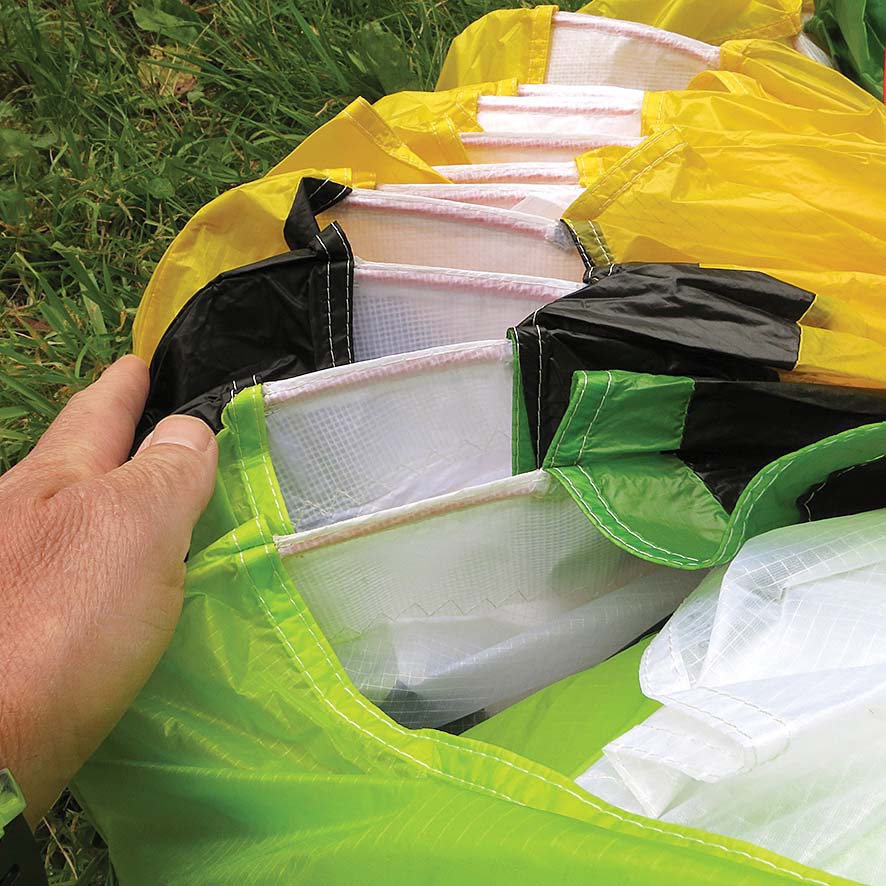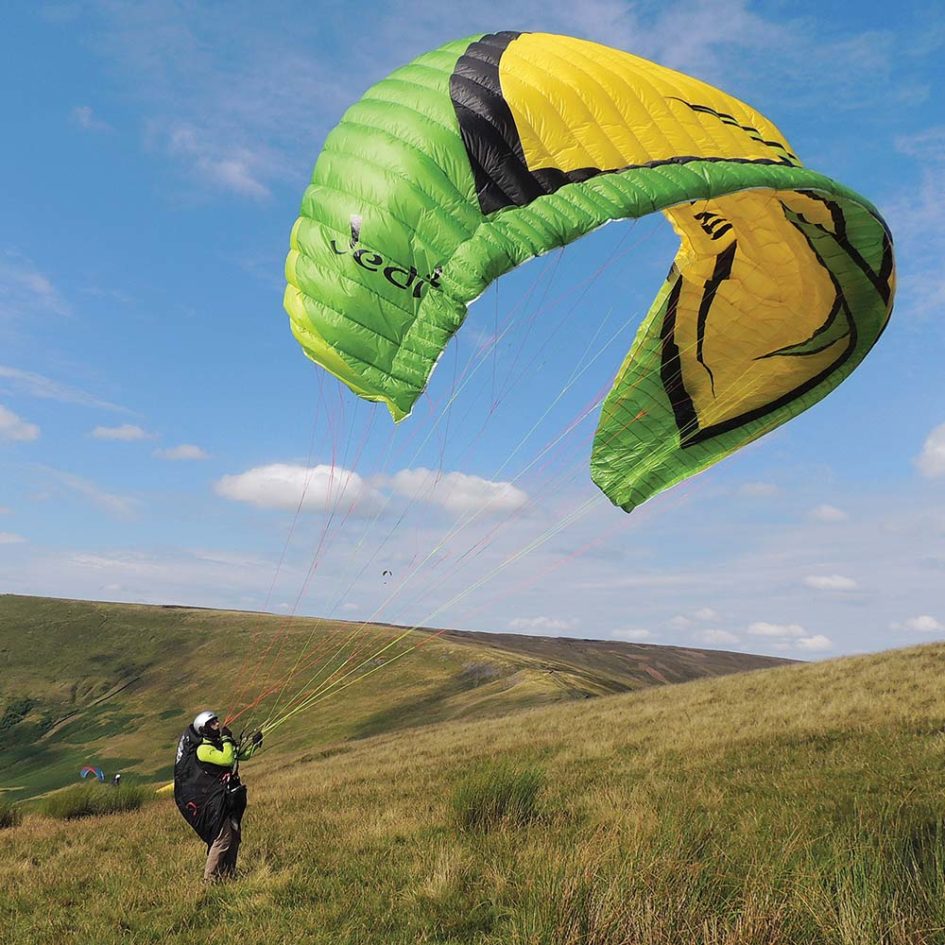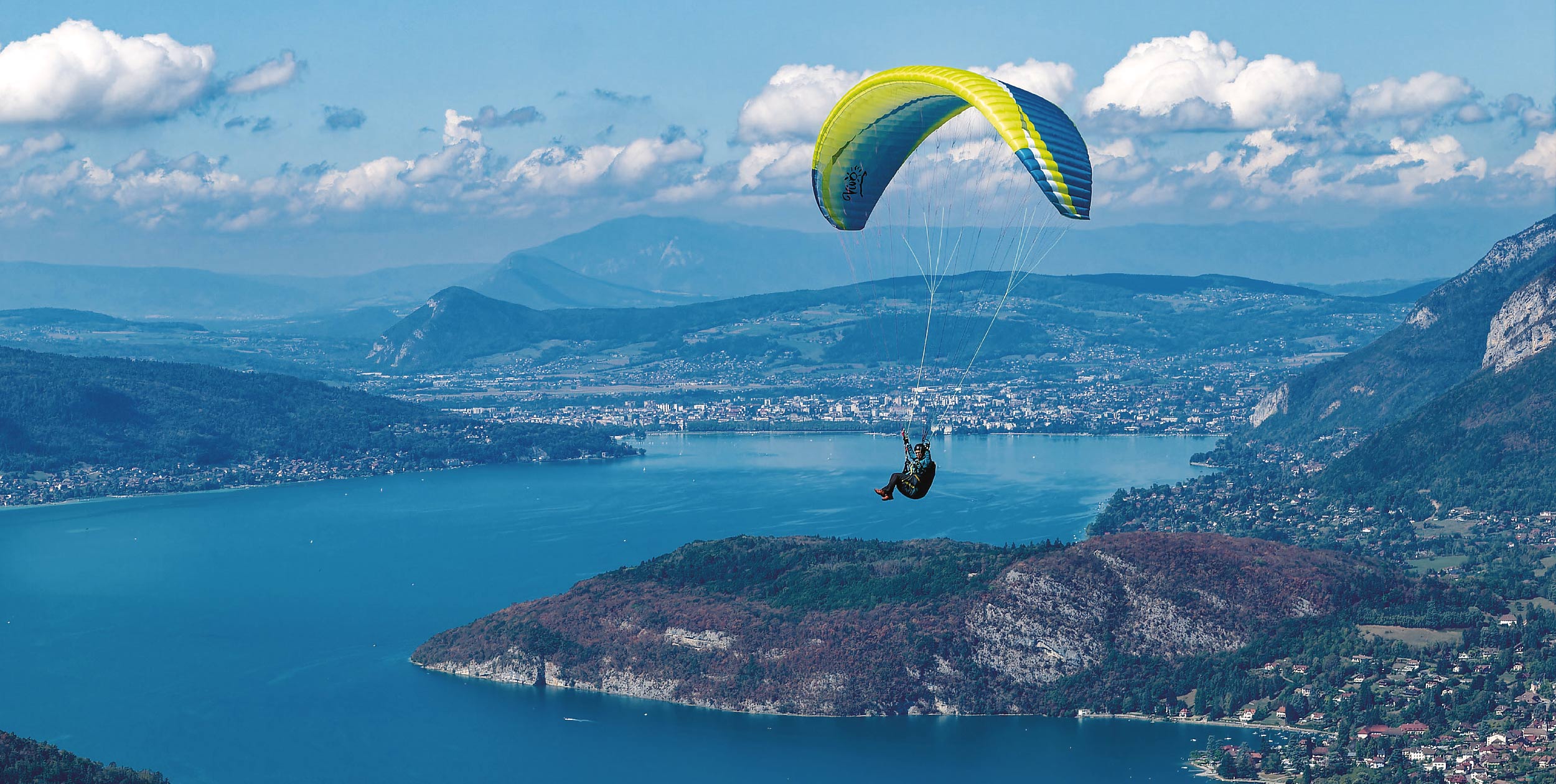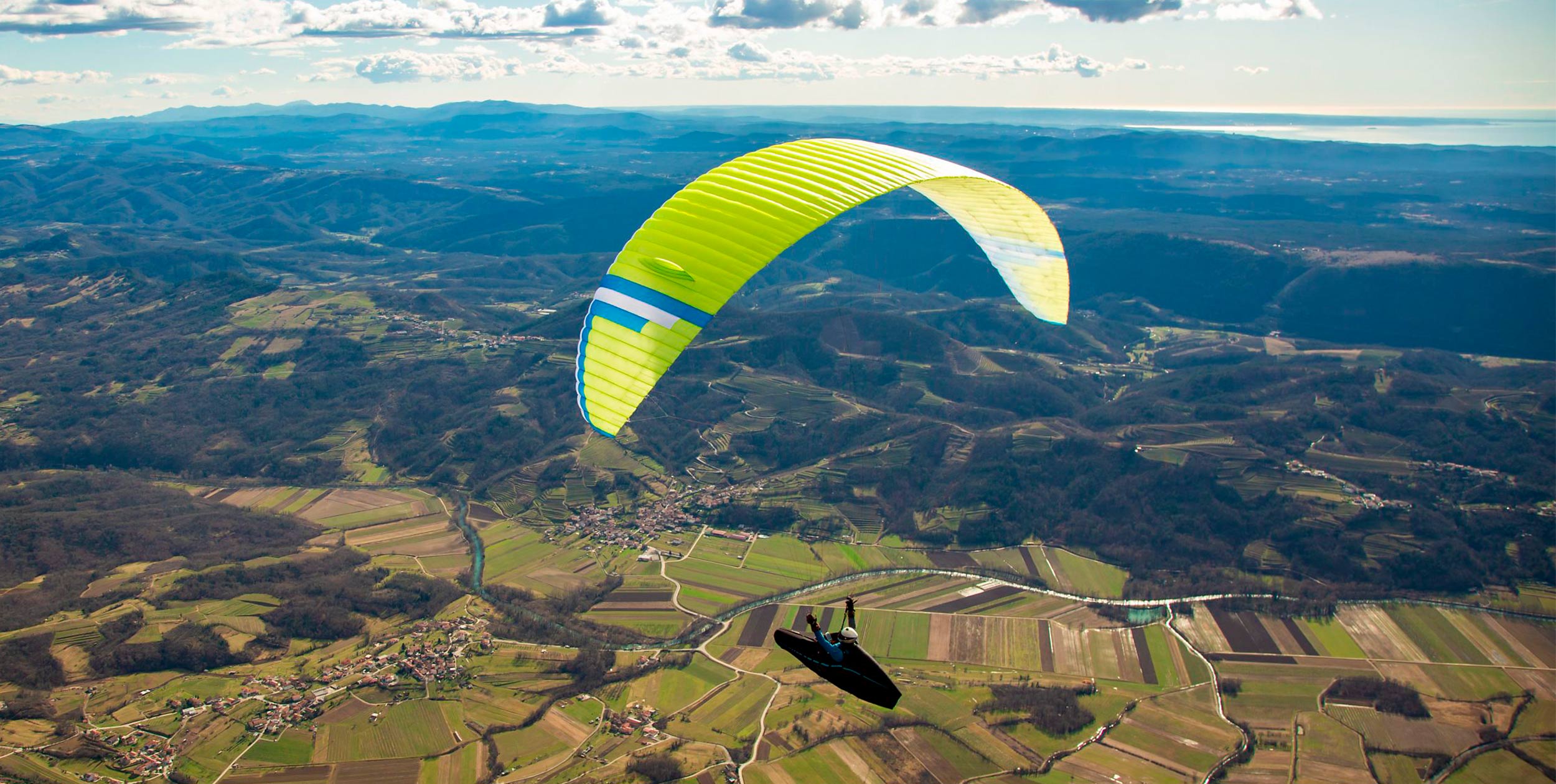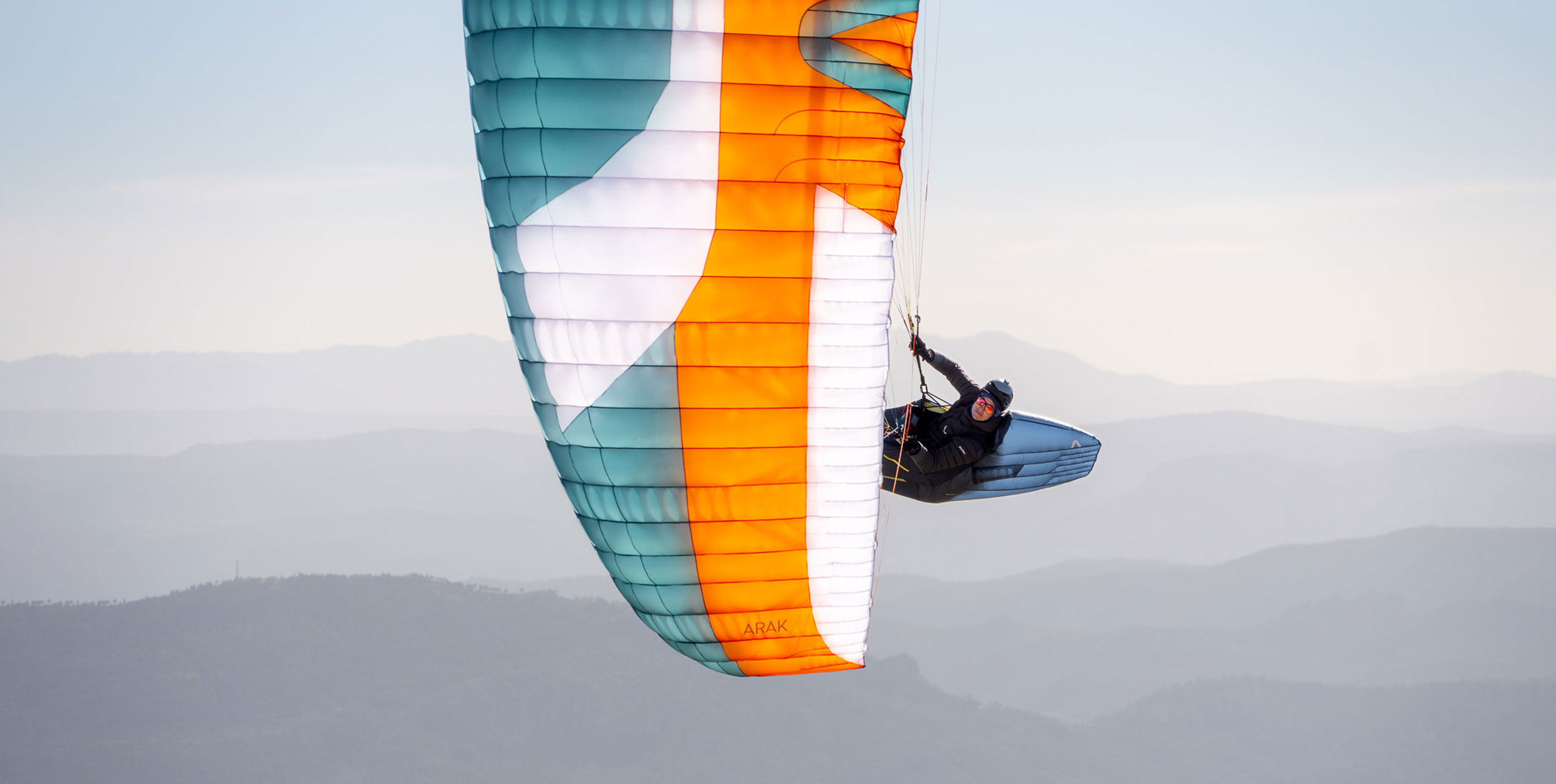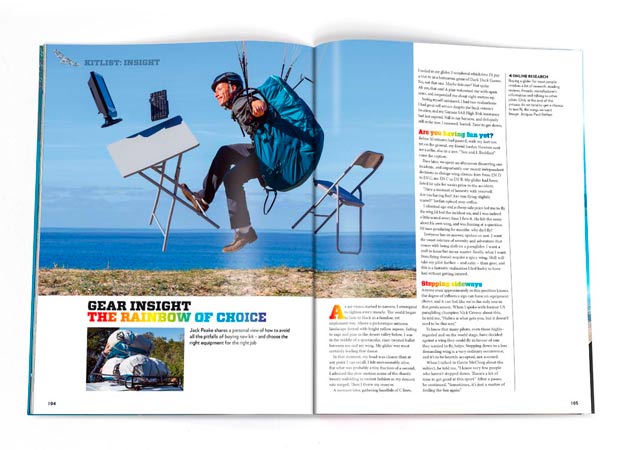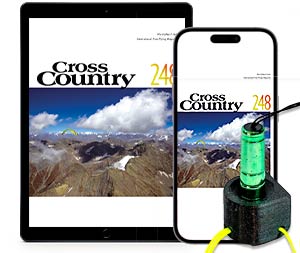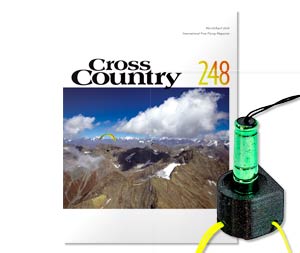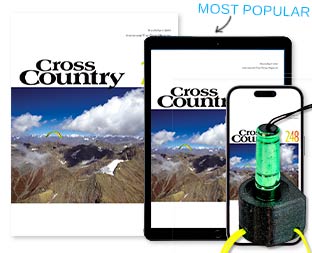AN ITV WING is a rare thing in my part of England these days. Not like the early ‘90s when they were the wing to have. Good performing and sweet handling. Their flagship, the Saphir, even managed that oft-repeated trick of looking benign in the certification tests even though it was for highly skilled pilots.
Then disaster struck. The material they used started going porous at an alarming rate and almost-new gliders became as useful as a second-hand teabag. ITV didn’t seem to recover and disappeared from view for years. Then gradually the name started appearing again. Now, there are no links to the past and ITV almost feels like a fresh face on the scene.
Attention to detail
The first thing is that the Jedi 2 is really nicely made with lovely attention to detail and a high-quality feel. Many EN B pilots will rejoice at the fully sheathed lines throughout. Many a time I hear comments such as, “I really like the so-and-so but I’m really worried about those unprotected lines.” Over the years I have got used to extra-thorough pre-flight checks and unsheathed lines, but the Jedi 2 lines are great – they just seemed to need a quick shake to free them, leaving not a tangle in sight.
The easy-life feel of the glider extended to launching and flying. I had mistakenly thought that the Jedi 2 is for pilots with high-EN B skills. I had to go back to the ITV website and check the target market for the glider because everything felt so accessible and predictable – mid-EN B at most.
ITV so far have not gone down the route of having two EN B models for free-flight – high and low-end – instead opting for a single glider with broad appeal. For launch it’s at the easier end of the spectrum within EN B. Whatever your normal technique is will serve you just fine.
In strong wind the C-risers will pin the glider down until you are ready to launch. Stepping towards the glider as it rises past 45 degrees takes all the sting out of the inflation and virtually no brake is needed to stop the glider. A- and C-riser inflations are super easy to control and very steerable if the glider comes up crooked.
First flights
Taking the small, gentle but broken thermals on offer on my first flight showed just how easy the glider is. Not too much movement; easy to hold a steady angle of bank; definitely efficient; very little attention needed to the outside brake. It seemed just as good as the Delta 2s, Cayenne 5 and various Sigmas I was flying with.
The Delta 2 and Cayenne were moving and pitching but frankly I felt like I was having a gentle go on the roundabout in a kids’ play park. Tightening on the little surges gained a bit more height and probably frustrated the hell out of the EN C pilots.
Leaving the thermal in search of another there was a mild forward pitching, but in a really calm way. I knew what the air was doing but there was enough damping to keep stress levels down for a wide range of pilots.
All of this sounds perfect but there must be a downside. The first thing is that you don’t feel the wing is especially agile when in cross-country thermal flight mode. Advance’s Iota (high EN B), for example, turns more instantly with a light touch of inside brake. On the Jedi 2 fast turns take effort and time to build up. It’s designed to cruise around like a limo rather than dart about like a go-kart. If you like a lot of weightshift response you might be disappointed.
All of that said, if you want to work on your wingovers the Jedi 2 comes alive and really does build up smoothly and predictably. Less chance of over-cooking compared with many other gliders.
Creamy smooth
A different day with a bit more mixing of the air as the sea breeze was trying to eat into the main thermic air mass, showed what a nicely rounded glider the Jedi 2 is. Scratching up a scree slope to get into the better air above was something that usually has me concentrating hard and feeling slightly nervous. The Jedi damped the bumps and surges and smoothly 180ed at the end of each beat.
Even above the ridge the air was a bit choppy but the glider took me smoothly around in 360s. I wouldn’t quite use the terms “planted” or “on rails”; it was probably more like stirring a light cake mix: just go round and round without needing to think too hard. Despite the “interesting” air, I could imagine many pilots enjoying the climb rather than running to the landing field.
My reference wing on this day was the Niviuk Ikuma 25 (same weight range). Swapping back and forth was like going from a smooth touring motorcycle to a middle-weight street bike. The Ikuma (high EN B) was harsher, bumpier and definitely a higher mental and physical workload. Not a criticism of the Niviuk, it brought the expected benefits as well as the costs of a slightly higher-level wing.
I felt the Jedi 2 didn’t bite into the surges of lift and power upwards quite as well so gradually lost a little compared to the Ikuma in suitably skilled hands. In better-formed thermals the Jedi was back on par in climb rate whist keeping its advantage in the workload department. ITV talk about the glider’s reassuring nature in strong conditions and I think they have called it about right.
On brake pressure, firm but not heavy would be the general description. When thermalling, the inner brake loads up steadily rather than suddenly. The outer brake is soft unless you pull down a fair way and doesn’t really seem to give a lot of benefit. How most pilots will probably fly the Jedi 2 – a touch of outer brake when thermalling – gives enough control and confidence to concentrate on other things.
Usable speed
Gliding around at trim against the Advance Iotas and the Ikuma showed the performance to be close, maybe the edge going to the Iota. Speed was similar as well both at trim and full speed. On the GPS I measured about 11km/h acceleration from trim to pulleys touching.
“Usability” is the key word when considering performance and the Jedi 2 scores really highly.
As with many of the latest designs, the polar curve doesn’t fall off a cliff and pilots should use the full speed range in normal flying. I kept full-bar pinned through medium level turbulence and the Jedi 2 stayed on line reasonably well and didn’t even feel like collapsing.
There was a bit more friction in the speed system than the best EN B systems, but nothing to discourage you from using it. The C lines go very slack on bar so the Jedi doesn’t feel like a natural rear-riser steerer. I did take out the slack for occasional course corrections but other than that pulling the rear risers just deformed the wing rather a lot if I searched for meaningful pitch control.
Getting down
ITV actually recommend B stall as one of the alternatives for getting down in a hurry. Personally I was happy with big ears, with or without speedbar. As it has only two A-lines per side, using the outer line on the separate riser, a good-sized ear folds in with a firm pull and sits in with no flapping or oscillating. They needed a bit of persuasion to open again; even though the last few cells have no reinforcement they do stick in a bit.
Top landing with deep brake was OK and on the second attempt I pushed really deep on the brake. The stall gave lots of notice and mushed rather than snapping in viciously.
Construction and extras
Everything on the glider is neat and tidy and well finished. The leading edge, whilst not sharky, is reinforced with thick short plastics and small mylar sections. No concertina bag is supplied but it doesn’t really need one – gathering the leading edge to keep the reinforcements flat is all that is needed. The rucksack is large, robust and comfortable. It doesn’t pack small though so it might be a bit of a squeeze to get it into your harness.
The lines are arranged in three rows with two lines on each A riser, three on each B and two on each C. Simple and clean. The rear riser has a red stripe along its back so checking it’s not twisted is easy. The glider has some of the biggest brake handles in the world.
Fans of flying with hands through the brakes (like me) can remove some of the doubt about being able to get their hands free in a hurry. I had doubts about the magnetic keepers when I saw that they are just two flat surfaces which come together. No recess or locating mechanism. In reality they worked perfectly and put the magnets on my Omega X-Alps to shame!
The verdict
It’s easy to see why so many ITVs fill the Annecy skies close to the company’s base in Doussard. The Jedi 2 might not stand out from the crowd (other than in its looks), but it’s a likeable, capable, low maintenance, smooth rounded intermediate glider. With mid-EN B demand and useable performance it’s very accessible and reassuring to fly.
****
Manufacturer’s Spec
What ITV say: “Aesthetically pleasing, a joy to fly, superb acceleration”
Use: Progession into XC. Paramotoring
Pilot level: Intermediate
Sizes: XS, S, M, L
Flat area (m2): 21, 23, 25, 27.5
Take-off weight (kg): 50-70, 65-85, 80-100, 95-120
Cells: 55
Flat aspect ratio: 5.7
Certification: EN B for S, M and L, EN C for XS. Also DGAC rated for paramotoring
Review pilot: Pat Dower flew the Medium (80-100kg) at 90kg with a Genie Lite 2 harness
To stay up to date and read our reviews first, subscribe to Cross Country


